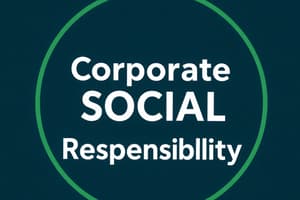Podcast
Questions and Answers
Which statement correctly describes a characteristic of Corporate Social Responsibility (CSR)?
Which statement correctly describes a characteristic of Corporate Social Responsibility (CSR)?
- CSR employs a one-size-fits-all model for all companies.
- CSR is mainly concerned with increasing short-term profits.
- CSR is aligned with the company's mission and values. (correct)
- CSR initiatives focus only on environmental sustainability.
What is a primary benefit of implementing CSR practices in a business?
What is a primary benefit of implementing CSR practices in a business?
- It guarantees immediate financial profit.
- It provides a legal defense against all business liabilities.
- It enhances corporate reputation and builds consumer loyalty. (correct)
- It solely focuses on reducing operational costs.
How do CSR initiatives contribute to risk management for companies?
How do CSR initiatives contribute to risk management for companies?
- By integrating responsible practices that mitigate potential risks. (correct)
- By focusing only on profit maximization strategies.
- By allowing companies to ignore regulatory requirements.
- By eliminating all possible risks in business operations.
Why is stakeholder inclusivity important in CSR initiatives?
Why is stakeholder inclusivity important in CSR initiatives?
What role do measurable impacts play in CSR initiatives?
What role do measurable impacts play in CSR initiatives?
What is the primary motivation behind the philanthropic model of CSR?
What is the primary motivation behind the philanthropic model of CSR?
Which CSR model focuses on aligning CSR efforts with a company's mission and values?
Which CSR model focuses on aligning CSR efforts with a company's mission and values?
In which model is adherence to ethical standards and principles emphasized?
In which model is adherence to ethical standards and principles emphasized?
What is the focus of the stakeholder model within CSR?
What is the focus of the stakeholder model within CSR?
What is a main characteristic of the environmental sustainability model?
What is a main characteristic of the environmental sustainability model?
Which motivation is primarily associated with the ethical model of CSR?
Which motivation is primarily associated with the ethical model of CSR?
Which model most likely does NOT fully integrate CSR into the core business strategy?
Which model most likely does NOT fully integrate CSR into the core business strategy?
What is the primary focus of the Ethical Model in Corporate Social Responsibility?
What is the primary focus of the Ethical Model in Corporate Social Responsibility?
Which of the following components is NOT a feature of Corporate Social Responsibility (CSR)?
Which of the following components is NOT a feature of Corporate Social Responsibility (CSR)?
What is the focus of the Shared Value Model in CSR?
What is the focus of the Shared Value Model in CSR?
How does Stakeholder Engagement contribute to a company's CSR efforts?
How does Stakeholder Engagement contribute to a company's CSR efforts?
Which model assesses a company's performance based on economic, social, and environmental outcomes?
Which model assesses a company's performance based on economic, social, and environmental outcomes?
What is a primary focus of the corporate citizenship model?
What is a primary focus of the corporate citizenship model?
Which model seeks to balance profit with social and environmental responsibilities?
Which model seeks to balance profit with social and environmental responsibilities?
What motivates companies to adopt eco-friendly practices?
What motivates companies to adopt eco-friendly practices?
In the shared value model, what is a key motivation?
In the shared value model, what is a key motivation?
Which of the following is NOT included in the triple bottom line model considerations?
Which of the following is NOT included in the triple bottom line model considerations?
What transformation do companies often make in their approach to CSR over time?
What transformation do companies often make in their approach to CSR over time?
What is a potential outcome of implementing the shared value model?
What is a potential outcome of implementing the shared value model?
Which motivation is common across various CSR models?
Which motivation is common across various CSR models?
Which focus is associated with eco-friendly practices in businesses?
Which focus is associated with eco-friendly practices in businesses?
What is a aspect of the corporate citizenship model that extends beyond philanthropy?
What is a aspect of the corporate citizenship model that extends beyond philanthropy?
Flashcards are hidden until you start studying
Study Notes
Corporate Social Responsibility (CSR)
- Definition: A business approach integrating social and environmental concerns into its strategy, aiming to benefit society while achieving financial goals.
- Characteristics:
- Strategic Integration: Woven into a company's strategy and operations, aligning with its mission and values.
- Holistic Approach: Encompasses various activities including environmental sustainability, social responsibility, ethical business practices, and community engagement.
- Stakeholder Inclusivity: Considers the interests of all stakeholders including employees, customers, suppliers, communities, and investors.
- Measurable Impact: Focuses on tracking key performance indicators (KPIs) related to sustainability, social impact, and ethical practices.
- Significance in Modern Business:
- Enhanced Corporate Reputation: Builds a positive image, crucial for attracting customers and investors in a transparent environment.
- Consumer Loyalty: Modern consumers value social and environmental impact, and loyalty is built by aligning with those values.
- Attracting Talent: Top talent seeks companies with purpose and social responsibility, a key factor in attracting, retaining, and motivating skilled employees.
- Risk Management: Acts as a buffer against potential risks, including legal, environmental, and reputational, by adopting responsible practices.
- Regulatory Compliance: Often aligns with emerging regulations and standards, positioning a company to stay ahead of changes and requirements.
- Long-Term Sustainability: A strategy for long-term success, going beyond a trend.
Models of Corporate Social Responsibility (CSR)
- Philanthropic Model:
- Focus: Charitable giving and community support. Companies engage in donating to charities, sponsoring events, and contributing to development projects.
- Motivation: Contribute to societal well-being and build a positive image, but may not be deeply integrated into the core business strategy.
- Ethical Model:
- Focus: Adhering to ethical standards in all business operations, such as fair labor practices, transparency, and honesty.
- Motivation: Conduct business in a morally upright manner, ensuring ethical operations and avoiding harmful practices.
- Strategic Model:
- Focus: Integrating CSR initiatives into the overall business strategy, viewing social and environmental responsibility as critical to success and competitiveness.
- Motivation: Leveraging CSR as a tool for enhancing business performance and reputation.
- Stakeholder Model:
- Focus: Engaging with and meeting the expectations of various stakeholders, including employees, customers, suppliers, and local communities.
- Motivation: Building positive relationships with stakeholders, understanding their needs, and ensuring contributions to the broader community's well-being.
- Environmental Sustainability Model:
- Focus: Minimizing the environmental impact of business operations, adopting eco-friendly practices such as reducing carbon emissions, conserving resources, and implementing sustainable supply chain management.
- Motivation: Promoting environmental stewardship, responding to climate change concerns, and meeting the expectations of environmentally conscious consumers.
- Corporate Citizenship Model:
- Focus: Extends beyond philanthropy to emphasize active participation and responsibility as a corporate citizen, making a positive impact on society through various initiatives.
- Motivation: Companies have a role and responsibility to contribute positively to their communities.
- Shared Value Model:
- Focus: Aligning business success with societal well-being, identifying opportunities where addressing social or environmental issues creates economic value.
- Motivation: Creating a win-win scenario for both the company and society, finding synergies between social impact and business objectives.
- Triple Bottom Line Model:
- Focus: Expands the traditional bottom line (profit) to include social and environmental performance, measuring success based on economic, social, and environmental outcomes.
- Motivation: Achieving a balance between profit, people, and the planet, demonstrating that economic success can coexist with social responsibility and environmental stewardship.
Key Terms
- Stakeholder Engagement: Involving and communicating with relevant parties, such as employees, customers, and communities, to understand and address their interests.
- Philanthropic Model: CSR model focused on charitable giving and community support through donations to organizations and projects.
- Triple Bottom Line Model: Approach that evaluates a company's performance based on economic, social, and environmental outcomes.
- Shared Value Model: CSR model that aligns business success with societal well-being by identifying opportunities where addressing social issues creates economic value.
- Ethical Model: CSR model emphasizing adherence to ethical standards in business operations, such as fair labor practices and transparency.
- Strategic CSR Initiatives: Integrating CSR into the overall business strategy, aligning initiatives with the company's mission and values for long-term success.
- Diversity, Equity, and Inclusion (DEI): Efforts to create a workplace that values and includes individuals from diverse backgrounds, ensuring equal opportunities for all.
- Environmental Sustainability Model: CSR model focused on minimizing environmental impact, including eco-friendly practices and conservation initiatives.
- Corporate Citizenship Model: CSR model emphasizing active participation and responsibility as a corporate citizen, contributing to the well-being of the communities in which the company operates.
Studying That Suits You
Use AI to generate personalized quizzes and flashcards to suit your learning preferences.




